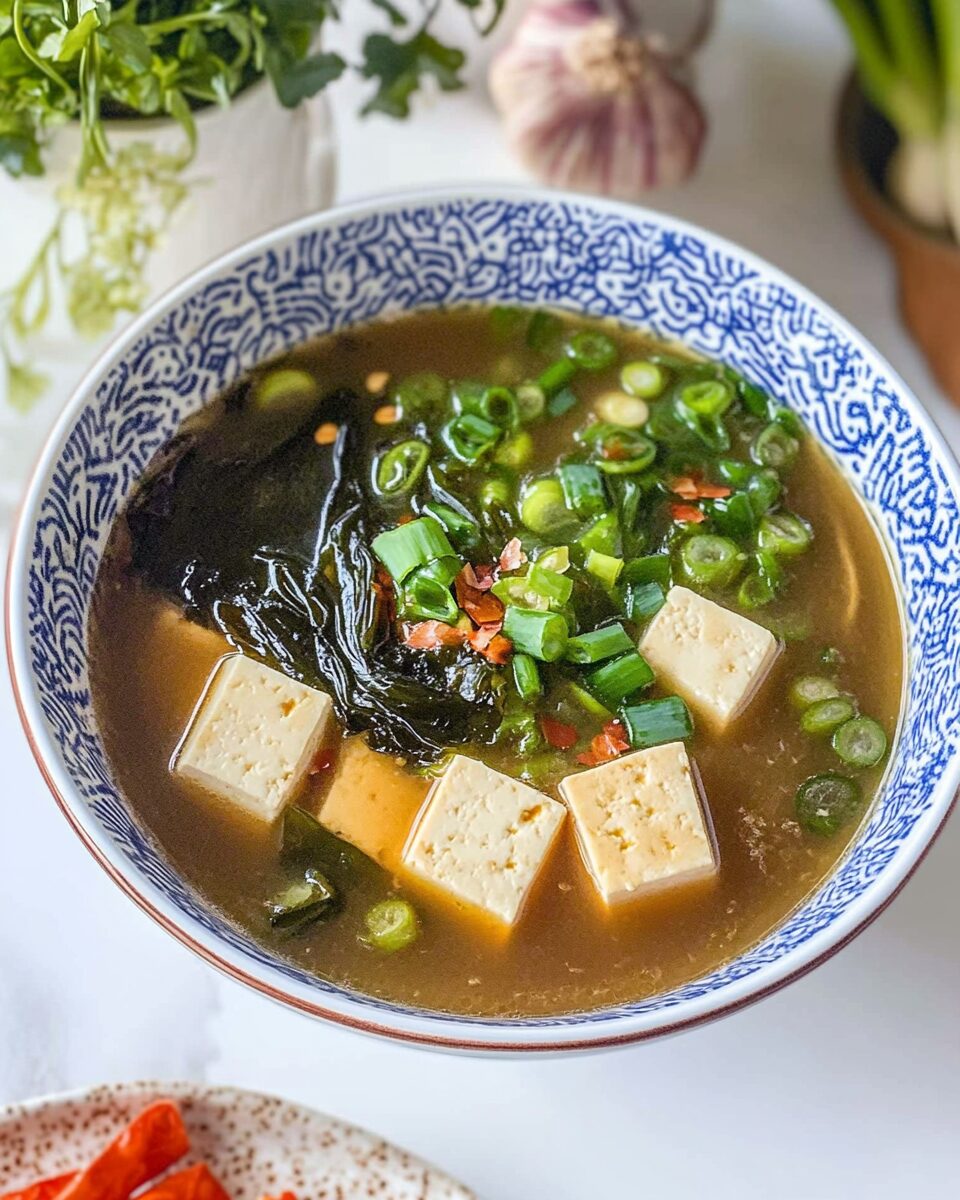This Silky Tofu Miso Soup captures the essence of simple, wholesome Japanese comfort food. The delicate cubes of silken tofu gently float in a savory miso broth, enhanced by the tender wakame seaweed and fresh scallions that add both texture and vibrant color.
Perfect for a quick and healthy meal, this soup warms you from the inside out with every spoonful. It’s incredibly easy to prepare yet delivers a depth of flavor that feels both satisfying and nurturing, ideal for chilly evenings or whenever you need a gentle pick-me-up.
Full Recipe:
-
4 cups vegetable broth
-
3 tablespoons white miso paste
-
1 block silken tofu, cubed
-
1/4 cup dried wakame seaweed
-
2 scallions, thinly sliced
-
1 tablespoon soy sauce (optional)
-
1 teaspoon sesame oil
-
1 clove garlic, minced
-
1 teaspoon fresh ginger, grated
-
Freshly ground black pepper, to taste
Directions:
-
In a medium pot, heat sesame oil over medium heat. Add garlic and ginger, sauté until fragrant, about 1 minute.
-
Pour in the vegetable broth and bring to a gentle simmer.
-
Add the dried wakame seaweed and simmer for 5 minutes until rehydrated.
-
In a small bowl, whisk the miso paste with a ladle of hot broth until smooth, then stir it back into the pot. Avoid boiling after adding miso to preserve its probiotics.
-
Gently add cubed silken tofu and warm through for 3-4 minutes without stirring vigorously to prevent breaking the tofu.
-
Season with soy sauce if desired and freshly ground black pepper.
-
Remove from heat and garnish with sliced scallions before serving.
Prep Time: 10 minutes | Cooking Time: 15 minutes | Total Time: 25 minutes
Kcal: 90 kcal | Servings: 4 servings
The Origins and Cultural Significance of Miso Soup
Miso soup is one of the most iconic dishes in Japanese cuisine, deeply rooted in tradition and daily life. Originating centuries ago, it was initially a simple, nourishing dish enjoyed by farmers and common folk, valued for its ability to provide warmth and energy during long days of labor. Over time, miso soup has transcended its humble origins to become a staple in Japanese households and restaurants worldwide. The base ingredient, miso paste, is fermented soybeans that have developed a complex umami flavor through a natural aging process, making it both nutritious and flavorful.
The addition of tofu, especially silken tofu, to miso soup reflects the adaptability of this dish. Tofu is a versatile plant-based protein source that complements miso’s savory notes while adding a silky texture that contrasts with the broth’s lightness. Wakame seaweed, another traditional ingredient, brings a subtle briny taste and a wealth of minerals, enhancing both the flavor and nutritional profile of the soup.
Nutritional Benefits of Silken Tofu Miso Soup
This soup is a powerhouse of nutrition while remaining light and low in calories. Silken tofu is rich in plant-based protein and contains all nine essential amino acids, making it a complete protein source ideal for vegans and vegetarians. It is also a good source of calcium, iron, and magnesium, important minerals for bone health and energy metabolism.
Miso paste offers probiotic benefits, thanks to the fermentation process that encourages the growth of beneficial bacteria. These probiotics help support gut health and enhance digestion. Additionally, miso contains vitamins B, E, and K, along with antioxidants that may aid in reducing inflammation and boosting immune function.
Wakame seaweed adds iodine, a mineral essential for thyroid function, and other trace minerals like calcium and magnesium. Its dietary fiber supports digestive health and contributes to feelings of fullness, which can be helpful for weight management.
The Role of Flavors and Ingredients in Balancing the Soup
The magic of silken tofu miso soup lies in the harmony of its ingredients. The miso paste imparts a rich umami depth, which is savory and slightly salty, but never overwhelming. The tofu balances this by bringing a mild creaminess that softens the broth’s intensity. Wakame seaweed offers a delicate oceanic flavor, grounding the dish with a natural saltiness that complements the miso.
Ginger and garlic add a subtle warmth and aromatic layer, elevating the soup without overpowering its simplicity. The gentle heat from ginger also supports digestion and circulation, while garlic contributes antimicrobial properties.
Sesame oil, used lightly in sautéing the aromatics, lends a nutty fragrance and rounds out the overall flavor profile. Scallions, sprinkled at the end, provide a fresh and slightly pungent contrast that enlivens the dish visually and gustatorily.
Why Silken Tofu is Ideal for This Soup
Silken tofu’s soft, custard-like texture is perfect for miso soup. Unlike firmer tofu varieties, silken tofu dissolves slightly into the broth while maintaining gentle, tender cubes that feel luxurious on the palate. Its neutral taste absorbs the broth’s flavors while providing a satisfying mouthfeel.
Because of its delicate nature, silken tofu must be handled gently during cooking to avoid breaking apart completely. The tofu’s creaminess also helps mellow the saltiness of miso paste, creating a balanced and comforting bowl.
Variations and Adaptations
One of the great things about miso soup is its flexibility. While this version focuses on silken tofu and wakame, you can customize it with a variety of ingredients depending on your preferences or seasonal availability.
For instance, adding mushrooms like shiitake or enoki introduces an earthy umami boost. Root vegetables such as daikon or carrots can add sweetness and heartiness. For a spicy twist, a dash of chili flakes or a drizzle of chili oil can awaken the palate.
Soy sauce or tamari can be added for additional depth or to adjust saltiness, especially if you prefer a stronger flavor. You can also experiment with different types of miso paste — white (shiro), yellow (shinshu), or red (aka) — which vary in intensity and fermentation time, altering the final taste of your soup.
The Importance of Miso Soup in Plant-Based Diets
For those following plant-based or vegan diets, silken tofu miso soup is an excellent dish to include regularly. It provides essential nutrients often sought after in plant-based eating, such as protein, calcium, and probiotics. Moreover, it is gluten-free (if you use gluten-free miso and soy sauce), dairy-free, and low in fat, making it accessible for people with diverse dietary needs.
Because it is light yet nourishing, this soup is perfect for balancing meals that may otherwise be heavy in grains or starches. It supports digestion, aids in hydration, and offers a comforting, flavorful way to start or end the day.
How to Serve and Enjoy Silken Tofu Miso Soup
Traditionally, miso soup is served as a starter or side dish accompanying Japanese meals like sushi, rice bowls, or grilled vegetables. However, it can also stand on its own as a light lunch or a soothing snack.
To enjoy it fully, serve the soup hot but not boiling, preserving the delicate flavors and probiotics in the miso paste. Garnish with fresh scallions or a sprinkle of toasted sesame seeds for added texture and aroma.
Pairing it with steamed rice, pickled vegetables, or a simple salad can round out the meal. The soup’s warmth and gentle complexity make it especially inviting during colder months or whenever you want a quick, wholesome comfort food.
Tips for Making the Perfect Silken Tofu Miso Soup
-
Use fresh, high-quality miso paste for the best flavor. Organic, traditionally fermented miso often has richer taste and better probiotic content.
-
Avoid boiling the soup after adding the miso paste, as excessive heat kills the beneficial bacteria and can alter the taste. Instead, stir in the miso last and heat gently.
-
Rehydrate wakame seaweed separately if desired, to control texture and saltiness.
-
Handle silken tofu carefully to prevent it from crumbling; add it at the end and warm gently.
-
Adjust the amount of miso paste according to taste and salt sensitivity.
Conclusion: Why Silken Tofu Miso Soup Should Be a Pantry Staple
Silken tofu miso soup is more than just a simple broth—it is a nourishing, flavorful, and versatile dish that brings balance to any meal. Its combination of wholesome ingredients, probiotic benefits, and comforting warmth makes it an excellent choice for anyone seeking healthful, plant-based options.
This soup exemplifies how minimal, natural ingredients can be transformed into a satisfying and elegant dish with layers of flavor and nutrition. Whether you are new to Japanese cuisine or a seasoned enthusiast, this easy-to-make soup offers a taste of tradition and wellness in every bowl. It’s perfect for busy weeknights, detox days, or whenever you need a moment of quiet comfort.
By including silken tofu miso soup in your cooking repertoire, you embrace a healthy lifestyle without sacrificing taste or simplicity. It’s a gentle reminder that sometimes the most unassuming dishes can leave the deepest impression.
Miso soup is one of the most iconic dishes in Japanese cuisine, deeply rooted in tradition and daily life. Originating centuries ago, it was initially a simple, nourishing dish enjoyed by farmers and common folk, valued for its ability to provide warmth and energy during long days of labor. Over time, miso soup has transcended its humble origins to become a staple in Japanese households and restaurants worldwide. The base ingredient, miso paste, is fermented soybeans that have developed a complex umami flavor through a natural aging process, making it both nutritious and flavorful.
The addition of tofu, especially silken tofu, to miso soup reflects the adaptability of this dish. Tofu is a versatile plant-based protein source that complements miso’s savory notes while adding a silky texture that contrasts with the broth’s lightness. Wakame seaweed, another traditional ingredient, brings a subtle briny taste and a wealth of minerals, enhancing both the flavor and nutritional profile of the soup.






